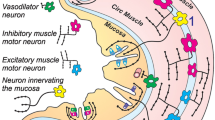Abstract
Applied research relating to the effect of SPV has so far produced the following results of practical importance:
-
1.
Selective complete denervation and devascularization of the proximal gastric region eliminates the cephalic phase. It influences antral motoricity somewhat if denervation is effected as far as the transitional zone, especially down to the “borderline nerves” in the crowsfoot. It produces insulin-negative behavior. Informations conveyed by the proximal afferents are lost.
-
2.
Conversely, insulin-stimulated secretion changes far less in cases where the distal stomach is denervated up to the crowsfoot. But the antrum loses its motoricity; it becomes atonic, empties only passively and retains considerable quantities. The decisive loss of motility can be attributed to cutting of the “borderline nerves”. Informations conveyed by the antral afferents are lost.
-
3.
The denervated antrum is a focus of disturbance, because the loss of information about distention and acidity is synonymous with disturbed motility and gastrin release.
-
4.
The vagal efferents to the proximal gastric part convey other (predominantly direct secretory) reflex qualities than that going to the antrum, which mainly transmit motor, i. e. peristalsis and gastrin-controlling reflexes.
-
5.
SPV, if executed correctly, is a complete and therefore practically reliable form of vagotomy. This is of great theoretical and practical importance. By separating, for example, the cephalic from the gastric phase, this method largely suppresses the vagalantral interrelation as regards secretion. As it leaves the motility intact and hardly falls short of direct vagal acid formation, it is the only form of vagotomy which will be considered in future for nonresecting treatment of gastroduodenal ulcers.
-
6.
SPV leads to insulin-negative behavior, yet such stomachs remain positive to feeding, i. e. the parietal cell still remains responsive to other stimulants, the most important of which is gastrin. This may also apply to stimulated endogenous gastrin, especially if, as is frequently the case, this is considerably increased after SPV.
-
7.
In animal experiments, SPV always produces a pH of 3.5; in humans, the pH values are generally even higher. The consequence of this permanent setting of the pH value to the marginal value of gastrin release and higher is an increase in basal gastrin, which is constantly released and continuously effective. Feeding or retention in the antrum increases this undesirable effect. It has the disadvantage, that it may cause gastric erosions and ulcers.
-
8.
Surgically, the harmful increase in gastrin can only be corrected by facilitating emptying of the stomach ( = pyloroplasty). Thanks to a complete neutralization of the interior of the stomach, broad pyloroplasty ( = Finney) again leads to an increase in gastrin as a consequence of duodenal reflux. Pyloroplasty should be applied in the form that assures most favorable emptying with the lowest possible duodenal reflux. This seems to be submucous pyloroplasty, which only weakens but does not destroy the pyloric sphincter mechanism.
-
9.
Basal pepsin concentration is reduced after SPV. Pentagastrin-stimulated total pepsin output is increased significantly. In conjunction with the increased gastrin release after feeding, this should be considered as a possible reason for recurrent gastric ulcer (gastrin/ pepsin/acid ulcer).
-
10.
We are approaching the time when inhibition of increased gastrin levels by a supply of artificial gastrin inhibitors (GIP), of increased Pepsin by Antipepsin and of the influence of disturbed antrum peristalsis by artificial gastro-intestinal-eflective hormone ( = Motilin) is becoming feasible. Until they are available, the majority of vagotomies should be combined with pyloroplasty based on form and function (cf. p. 169).
-
11.
The significance of the vagus nerve for secretion and motility may, as a consequence, be briefly defined (Holle, 1968, fig. 1) as a mediator for the transmission of reflexes within a feedback control circuit.
Access this chapter
Tax calculation will be finalised at checkout
Purchases are for personal use only
Similar content being viewed by others
References
Andersson, S.: Mechanism of gastrin liberation. Verh. Dtsch. Ges. Inn. Med. 75, 233 (1969)
Grossman, M. J.: Integration of neural and hormonal control of gastric secretion. Physiologist 6, 349(1963)
Gürtner, Th., Kreutzberg, G. W., Holle, F.: N. vagus und cholinergisches System am Magen des Menschen. II. Cholinergische Versorgung des menschlichen Magens. Münch. Med. Wschr. Med. Wschr. 109,1775(1967)
Iggo, A.: Gastric mucosal chemoreceptors with vagal afferent fibres in the cat. Quart. J. exp. Physiol. 42, 398–409 (1957)
Holle, F.: Pathophysiologische Grundlagen physiologischer Operationen in der Ulcuschirurgie. I. Colloqu. S. F. B. 37, Med. Fakultät Univ. Miinchen (Dec. 1968)
Leonard, A. S., Long, D. M., Thomas, F., Nicoloff, D. M., Wangensteen, O. H.: Influence of the Hypothalamus on gastric hydrochloric acid secretion. J. Amer. Med. Assoc. 183, 1016–1018 (1963)
Nyhus, L. M.: Vagotomy. Experimental and Clinical reflection. Symposium, London, May 1973. London: Butterworth 1973.
Takeshima, T.: Functional classification of the vagal afferent discharges in the dog’s stomach. Jap. Journ. Smooth Muscle Research 7,19–27 (1970)
Wagner, R.: Probleme und Beispiele biologischer Regelung. Stuttgart: Thieme 1954
Wagner, R.: Abhandlungen über die Pathophysiologic der Regulationen. Jena: Fischer 1958
Editor information
Editors and Affiliations
Rights and permissions
Copyright information
© 1974 Springer-Verlag Berlin · Heidelberg
About this chapter
Cite this chapter
Holle, F. (1974). Model of the Regulation of Secretion and Motility of the Stomach as a Feedback Circuit and its Practical Application. In: Holle, F., Andersson, S. (eds) Vagotomy. Springer, Berlin, Heidelberg. https://doi.org/10.1007/978-3-642-65889-1_28
Download citation
DOI: https://doi.org/10.1007/978-3-642-65889-1_28
Publisher Name: Springer, Berlin, Heidelberg
Print ISBN: 978-3-540-06801-3
Online ISBN: 978-3-642-65889-1
eBook Packages: Springer Book Archive




